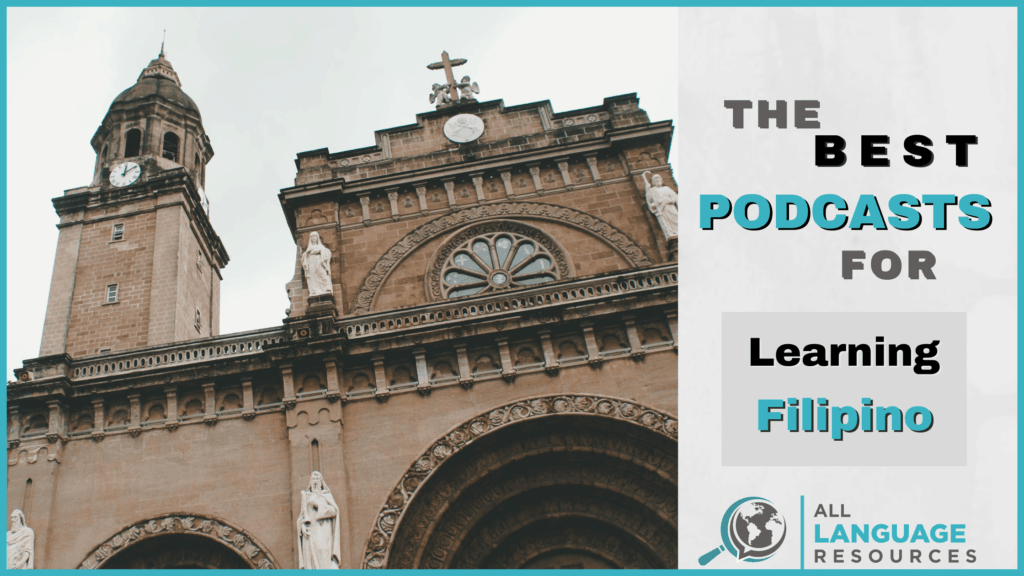The Philippines comprises over 7,600 islands on which anywhere from 120 to almost 200 languages are spoken. In the late 1930s, after Philippine independence, a standardized form of Tagalog was chosen as the basis for a national language. Tagalog was a native Philippine language that was already prominent in Manila and several other cities. The hope was that standardized Tagalog — renamed ‘Pilipino’ in 1959. and then called ‘Filipino’ in the late 1980s — would gradually incorporate words from many other local languages, evolving into an amalgam that better represented many Filipino languages and cultures.
Podcasts for Beginners
If you have absolutely zero experience with learning Filipino, or if you just don’t know enough to carry a short conversation, then you’re going to want to start here.
FilipinoPod101

FilipinoPod101 starts you off with the very beginner-level basics and then works you up into more intermediate-level and advanced concepts. You’ll learn lots of vocabulary words and grammar concepts.
For those who are more interested in just learning Filipino for the purposes of a work or leisure trip to the Philippines, then you’ll find a special set of episodes of the podcast that are geared just toward travelers. This quick series gives you the bare bones of what you might need to get through a trip and can be easily consumed on a plane before your arrival in the country.
Do note that the majority of FilipinoPod101’s resources are hidden behind a paywall, so you won’t be able to access some of the extra educational tools without a subscription. However, subscriptions are very affordable. You can learn more by reading our full review of FilipinoPod101.
Learn Filipino with TagalogJuan
This beginner-level podcast offers 21 episodes that are around 10 minutes each. The podcast is no longer being updated, but you’ll find the episodes that do exist to be quite helpful in teaching you vocabulary words and phrases that might come in handy when speaking with a native Tagalog speaker.
Go Filipino: Let’s Learn Tagalog

This newer podcast is still being updated, with new episodes uploaded every few weeks. You’ll find more than 20 lessons currently available, with episodes focusing on parts of grammar. Learn about adjectives, pronouns, root words and more. The podcast is hosted by a language expert and provides exercises to help you understand Tagalog so that your speaking skills are eventually on par with those of a native speaker.
Learn Tagalog Filipino Show

Learn Filipino with the help of native Filipino speakers. Enjoy extensive training over the course of more than a dozen episodes. The focus is on conversational Tagalog and Filipino words and phrases. The podcast also offers separate paid services, such as one-on-one lessons and online chat sessions.
No Borders Tagalog

Learn Tagalog with basic beginner lessons aimed toward those who have no prior experience learning any words or grammar concepts. While this podcast is no longer being updated, it does offer a handful of useful episodes that teach you phrases and vocabulary that you would need while traveling, including information on how to conduct a simple conversation and how to put your Tagalog words in the correct order.
Intermediate
If you have a good understanding of the way the Filipino language works and you’re able to mostly follow along to spoken Filipino and Tagalong, but could still use extra practice keeping up, try a Filipino podcast that comes with an English translation, so you can practice at your own pace.
Daily Tagalog Mass Readings

If you’re Catholic, this podcast with its daily Tagalog and Filipino mass readings could be a good resource for you. New content is uploaded daily and you’ll be able to easily find the English transitions of the readings online. Then, you can read along as you listen to the Filipino words. Each podcast episode is under 10 minutes in length, making them a convenient addition to just about any schedule.
Advanced
If you can follow along with spoken Tagalog pretty well and don’t feel as if you need a translation guide when listening, it might be time to move on to podcasts that Filipinos would listen to.
SBS Filipino

Non-native speakers are likely to have success with SBS Radio Filipino. The program is spoken entirely in Filipino and covers world events, news, interviews, stories, and issues. This means you’re likely already familiar with the topics covered if you stay up-to-date on international news at all.
Final Thoughts
Learning Filipino is an admirable endeavor and one that must be taken seriously in order to see success. Luckily there are plenty of online resources like podcasts out there that can help you learn the language.
Are there any good Filipino language-learning podcasts that we missed in our list above? Let us know about them!
Learning Filipino? Check out our guide on Tips and Resources for Learning Filipino, where you can find courses, apps, books, movies, and more useful information for learners.


Hi I would like to correct some things while Filipinos used Tagalog and Filipino interchangeably. I’m going to say the difference Tagalog is a dialect and Filipino is a whole language.
A dialect is a form of the language and Tagalog is the most popular and most used. We have other dialects that make up the Filipino language such as cebuano, ilocano and other different regions.
Filipino is basically a language combined with different types of dialect.